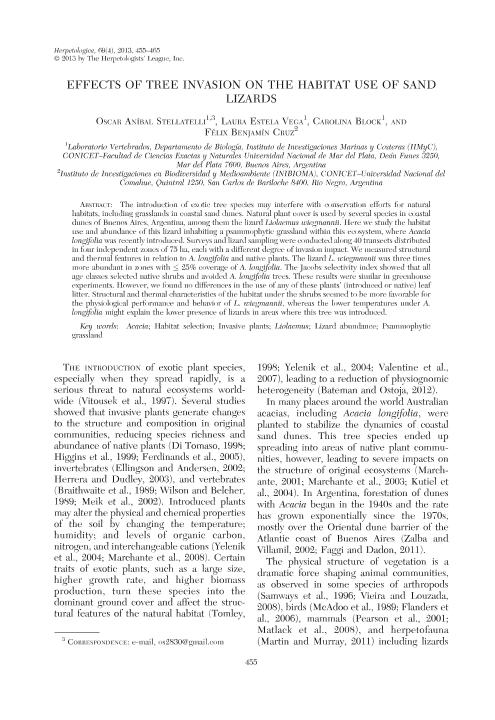Mostrar el registro sencillo del ítem
dc.contributor.author
Stellatelli, Oscar Aníbal

dc.contributor.author
Vega, Laura Estela
dc.contributor.author
Block, Carolina

dc.contributor.author
Cruz, Felix Benjamin

dc.date.available
2016-09-07T20:14:42Z
dc.date.issued
2013-11
dc.identifier.citation
Stellatelli, Oscar Aníbal; Vega, Laura Estela; Block, Carolina; Cruz, Felix Benjamin; Effect of the tree invasion on the habitat use of sand lizard; Herpetologists League; Herpetologica; 69; 4; 11-2013; 455-465
dc.identifier.issn
0018-0831
dc.identifier.uri
http://hdl.handle.net/11336/7549
dc.description.abstract
The introduction of exotic tree species may cause conservation problems to natural habitats, also true for original grasslands in coastal sand dunes. Natural plant cover is used by several species in coast line dunes of Buenos Aires, Argentina, among them the lizard Liolaemus wiegmannii. Here we study the habitat use and abundance of this lizard inhabiting psammophytic grassland in the coastal sand dunes of Buenos Aires, Argentina, where recently Acacia longifolia was introduced. Surveys and lizard sampling were conducted in 40 transects distributed in four independent zones of 75 ha, each one with a different degree of invasion impact. We measured structural and thermal features in relation to A. longifolia and native plants. The lizard L. wiegmannii was three times more abundant in zones with equal or lower than 25 % percent of coverage of A. longifolia. The Jacobs selectivity index showed that all age classes selected native shrubs and avoided A. longifolia trees. These results were similar in green house experiments. However, we found no significant differences in the use of any of these plants (introduced or native) leaf litter. Structural and thermal characteristics of the habitat under the shrubs seemed to be more favorable for the physiological and behavioral performances of L. wiegmannii, whereas the lower temperatures under A. longifolia may explain the lower presence of lizards in areas where this tree was introduced.
dc.format
application/pdf
dc.language.iso
eng
dc.publisher
Herpetologists League

dc.rights
info:eu-repo/semantics/openAccess
dc.rights.uri
https://creativecommons.org/licenses/by-nc-sa/2.5/ar/
dc.subject
Acacia
dc.subject
Habitat Selection
dc.subject
Invasive Plants
dc.subject
Liolaemus
dc.subject
Lizard Abundance
dc.subject
Psammophytic Grassland
dc.subject.classification
Ecología

dc.subject.classification
Ciencias Biológicas

dc.subject.classification
CIENCIAS NATURALES Y EXACTAS

dc.title
Effect of the tree invasion on the habitat use of sand lizard
dc.type
info:eu-repo/semantics/article
dc.type
info:ar-repo/semantics/artículo
dc.type
info:eu-repo/semantics/publishedVersion
dc.date.updated
2016-07-22T18:52:03Z
dc.journal.volume
69
dc.journal.number
4
dc.journal.pagination
455-465
dc.journal.pais
Estados Unidos

dc.journal.ciudad
Lawrence
dc.description.fil
Fil: Stellatelli, Oscar Aníbal. Consejo Nacional de Investigaciones Científicas y Técnicas. Centro Científico Tecnológico Mar del Plata. Instituto de Investigaciones Marinas y Costeras; Argentina
dc.description.fil
Fil: Vega, Laura Estela. Consejo Nacional de Investigaciones Científicas y Técnicas. Centro Científico Tecnológico Mar del Plata. Instituto de Investigaciones Marinas y Costeras; Argentina
dc.description.fil
Fil: Block, Carolina. Consejo Nacional de Investigaciones Científicas y Técnicas. Centro Científico Tecnológico Mar del Plata. Instituto de Investigaciones Marinas y Costeras; Argentina
dc.description.fil
Fil: Cruz, Felix Benjamin. Consejo Nacional de Investigaciones Científicas y Técnicas. Centro Científico Tecnológico Patagonia Norte. Instituto de Investigación En Biodiversidad y Medioambiente; Argentina
dc.journal.title
Herpetologica

dc.relation.alternativeid
info:eu-repo/semantics/altIdentifier/url/http://www.bioone.org/doi/abs/10.1655/HERPETOLOGICA-D-12-00033?journalCode=herp
dc.relation.alternativeid
info:eu-repo/semantics/altIdentifier/doi/http://dx.doi.org/10.1655/HERPETOLOGICA-D-12-00033
Archivos asociados
